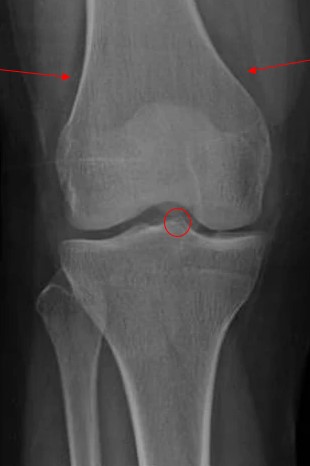Published on
Differential Diagnosis
- Posterior cruciate ligament (PCL) tear
- Anterior cruciate ligament (ACL) tear
- Tibial plateau fracture
- Patellar tendon tear
Diagnosis
The correct diagnosis is an ACL tear. In the anterior-to-posterior view, tibial eminence avulsion fracture (circle) overlying tibial spines and large effusion (arrow) can be seen. ACL tears are usually caused by forceful hyperextension of the knee or by a direct blow over the distal end of the femur with the knee flexed. Such an injury typically involves separation of the tibial attachment of the ACL to variable degrees, while separation at the femoral attachment is rare.

What to Look For
- On exam, there is frequently a large knee joint effusion and initially patient is unable to bear weight
- On exam, a positive Lachman’s test or anterior drawer test is present
Pearls for Urgent Care Management
- On exam, ensure that all other ligaments are intact, including the PCL
- MRI is the imaging modality of choice to confirm diagnosis
- Initial treatment is rest, ice, compression, elevation, pain management and non-weight bearing if knee is unstable
- Referral to orthopedic surgery is indicated for further consideration of operative versus non-operative management
Click Here to download the article PDF
42-Year-Old Soccer Player With Knee Injury
1 2
